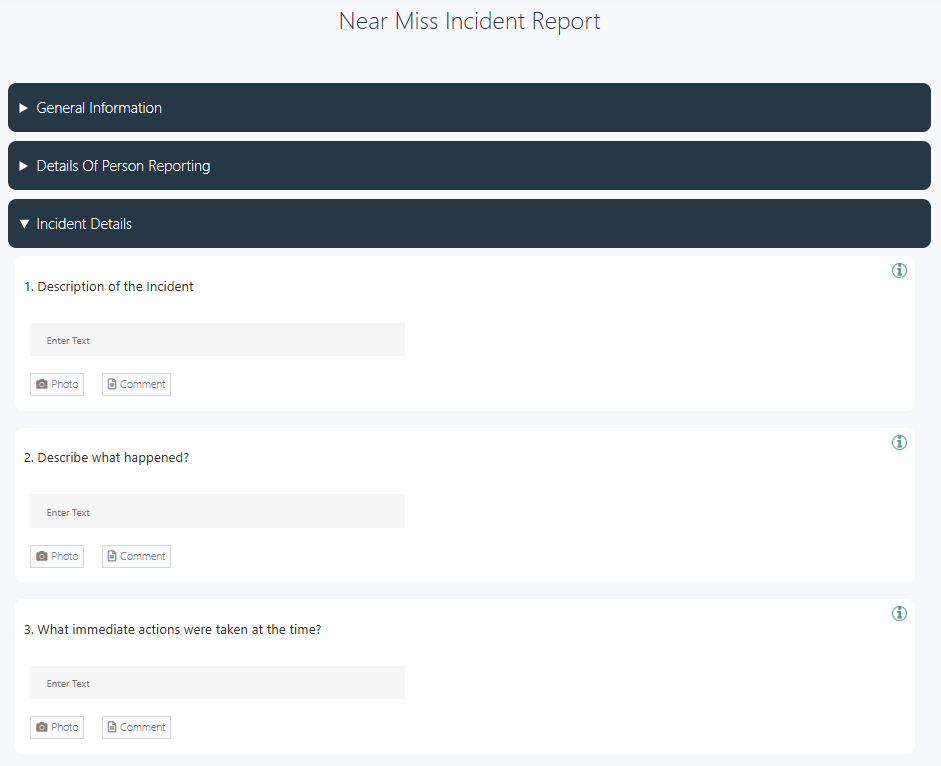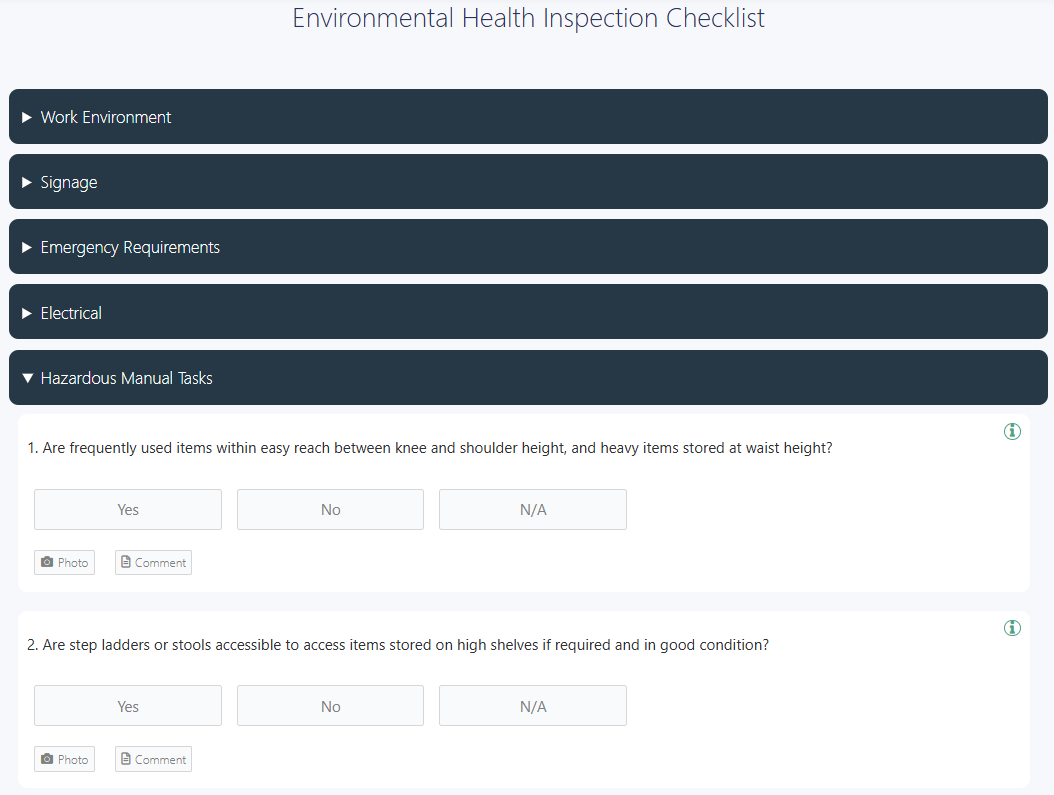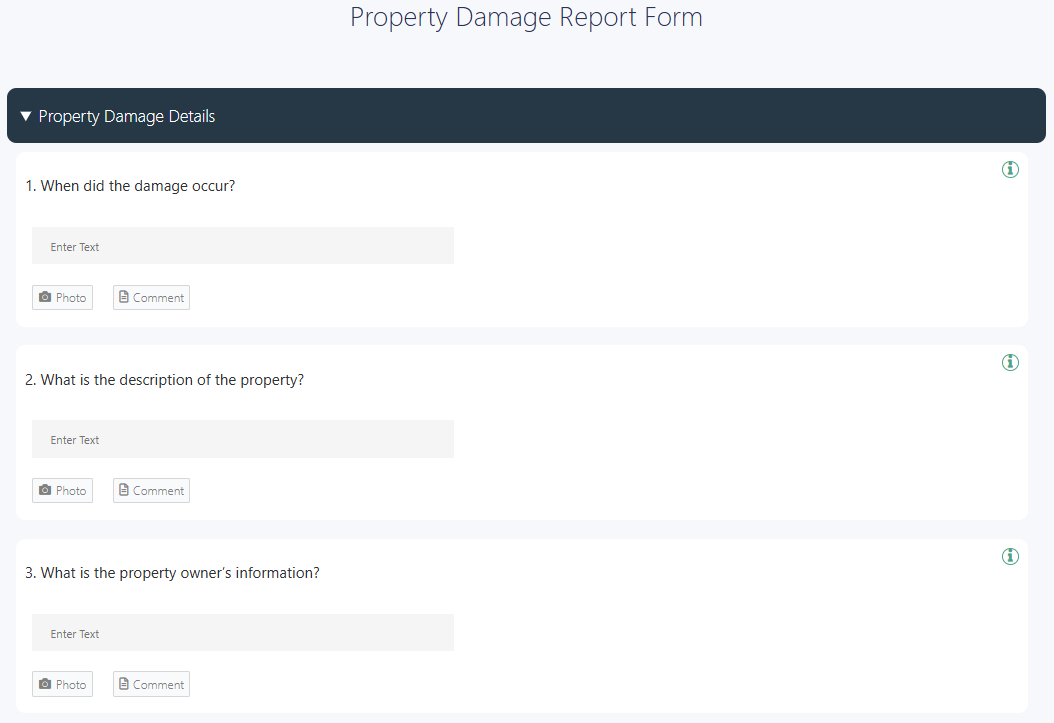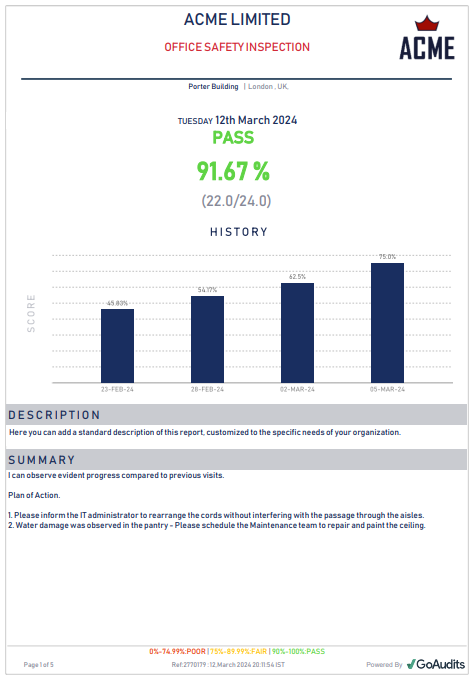Environmental, Health, and Safety (EHS) incident reporting is essential to ensure occupational health and safety, enabling organizations to systematically document and analyze workplace incidents. EHS reports not only help in identifying potential hazards but also facilitate the implementation of corrective measures. EHS incident reporting and investigating incidents can help organizations uncover underlying issues that may compromise safety and environmental standards, mitigate risks, and enhance operational efficiency and employee well-being.
This article will explore how EHS incident reporting empowers organizations to preemptively address challenges and optimize safety protocols, in addition to steps to create effective EHS reports.
- What is an EHS Report?
- Types of Incidents Covered in EHS Reports
- Components of EHS Report Templates
- EHS Report Template: Free PDF Download
- How to Create EHS Reports?
- Leverage GoAudits for EHS Inspections & Reporting
- How EHS Reporting Reduces Workplace Incidents
- What is EHS Incident Reporting Software
- How to Choose the Right EHS Incident Reporting Software?
What is an EHS Report?
EHS reports are comprehensive documents used to record, manage, and investigate incidents related to environment, health, and safety (EHS) within a workplace. These reports help organizations systematically track and address a wide range of events to maintain a safe, healthy, and compliant work environment. An EHS report is prepared whenever an event or activity occurs that could impact environmental, health, or safety conditions within a workplace.
Common triggers for preparing an EHS report include:
- Workplace incidents such as injuries, illnesses, or exposures
- Near misses (incidents that could have resulted in harm but did not)
- Environmental events like spills, releases, or non-compliance
- Property damage, equipment failures, or security lapses
EHS reports are typically required to be completed as soon as possible after an incident occurs, often within 24 hours, to ensure timely documentation, investigation, and corrective action. Regular EHS reports, such as weekly or monthly summaries, are also prepared to reflect overall EHS performance and compliance.
EHS reports are typically prepared by EHS professionals, such as EHS managers or specialists, within an organization or by third-party consultants. These individuals are responsible for managing and overseeing the environmental, health, and safety aspects of an organization.
What are the Different Types of EHS Reports?
In addition to documenting and reporting workplace incidents, EHS reports are also used for the following purposes.
Safety Audit and Inspection Reports
They help you identify hazards, evaluate risk controls, and ensure adherence to safety protocols. These reports are typically generated after scheduled or surprise inspections, covering equipment, work areas, procedures, and employee practices.
Key elements include a description of the audit or inspection scope, a list of observed hazards or unsafe practices, an evaluation of current control measures, recommendations for corrective actions, and assigned responsibilities and timelines for resolution.
EHS Compliance Reports
They are required during external or third-party audits by regulatory bodies, ensuring that you meet applicable regulations, or internal reviews to demonstrate due diligence. They typically contain a summary of applicable laws and standards, the status of permits and licenses, records of compliance activities, any violations or non-conformities identified, and follow-up actions or measures.
EHS Performance Reports
They provide insights into trends, the effectiveness of initiatives, and areas needing improvement by measuring how well your organization is meeting its safety, health, and environmental goals. They help you analyze common health and safety metrics, including incident rates, near-miss frequency, environmental impact indicators, training completion rates, progress on sustainability targets, and more.
Types of Incidents Covered in EHS Reports
Understanding the types of incidents covered in EHS reports enables you to implement effective preventive measures and foster a culture of safety.
Injuries, Illnesses, or Exposures
These incidents involve any work-related physical harm, occupational illnesses, or exposures to hazardous substances. Examples include chemical burns, respiratory issues from inhaling toxic fumes, or infections contracted in laboratory settings.
👉 GoAudits offers a wide range of free checklists to prevent occupational injuries, illnesses, and exposure to hazardous substances.
- Hazardous Material Inspection Checklist
- OSHA Heat-Related Illness Prevention Checklist
- Heat Illness Prevention Checklist
- OSHA Respiratory Protection Standard Checklist
Near Misses
A near miss refers to an unplanned event that did not result in injury, illness, or damage but had the potential to do so. For instance, a tool falling from a height without hitting anyone or a chemical spill that was quickly contained.
👉 Find out how GoAudits near miss reporting software can simplify the process of near miss reporting in your organization.
You can use this free near miss reporting checklist to identify hazards, prevent near misses, and ensure employee safety.
Environmental Incidents
These incidents pertain to events that cause or have the potential to cause environmental harm. Examples include chemical spills, unauthorized emissions, or improper waste disposal. Such incidents can lead to regulatory penalties and long-term ecological damage if not promptly addressed.
👉 You can use this free environmental health inspection checklist to perform thorough assessments and ensure compliance with health and safety standards in your organization.
Motor Vehicle Accidents
Incidents involving vehicles used for work purposes fall under this category. They encompass collisions, pedestrian accidents, or damage caused during the operation of company vehicles.
👉 Use the GoAudits vehicle inspection app & software to report these motor vehicle incidents. You can use these vehicle safety inspection checklists to identify and assess potential issues with vehicles.
Property Damages
It includes any damage to company property, equipment, or infrastructure not resulting from natural causes. Examples are machinery breakdowns due to misuse or structural damage from accidents.
👉 You can use this free property damage report form to record incidents and injuries and evaluate asset management and maintenance procedures.
Fire Incidents
Fires, regardless of their size or impact, are critical to report. They may result from electrical faults, flammable material mishandling, or equipment overheating.
👉 GoAudits fire inspection software offers a wide range of fire safety audit checklists to document fire incidents, evaluate emergency response plans, and review fire safety measures.
- Property Fire Risk Assessment
- Fire Sprinkler System Inspection Checklist
- Fire Protection Equipment Checklist
- Fire Door Inspection Checklist
- NFPA 25 Fire Pump Inspection Checklist
- Fire Drill Checklist Template
- OSHA Fire Protection Checklist
- Fire Extinguisher Checklist
- Fire Damper Inspection Checklist
- Fire Suppression System Inspection Checklist
Components of EHS Report Templates
A standard EHS report format should include the following elements.
Basic Information
Start with clear, factual details about the incident, including the date and time of occurrence, exact location, name and contact details of the person reporting, and people involved directly or indirectly. EHS report templates should also include the incident description, including the type of incidents, immediate and potential long-term impacts, etc., and firsthand accounts from those who observed the event.
Compliance Status
Documenting compliance status helps identify areas needing corrective action and monitor adherence to relevant EHS regulations and standards. EHS report templates should capture whether the incident breached any legal or internal compliance requirements.
Training Records
Including training records of personnel involved in the incident provides context regarding their preparedness and awareness. It can also highlight training gaps and inform future educational initiatives. EHS report templates should detail completed training sessions, dates, and content relevance.
Performance Metrics
Tracking performance metrics offers insights into the organization’s safety performance over time. Key indicators to include in the EHS report template are:
- Total recordable incident rate (TRIR) measures the number of recordable incidents per 100 full-time employees annually.
- Lost time incident rate (LTIR) calculates incidents resulting in lost workdays.
- Near-misses and first-aid cases
- Work-related health issues
- Lost workdays quantifies the total days lost due to incidents
- Findings from regular safety audits and hazard assessments
Incorporating these metrics facilitates trend analysis and supports targeted safety improvements.
Corrective and Preventive Actions (CAPA)
It outlines the steps taken to address the root causes of the incident and prevent recurrence. Each action should be clearly defined, assigned to responsible individuals, and include implementation timelines. Tracking the status of these actions ensures accountability and effectiveness in mitigating risks.
Environmental Data
Capturing environmental data related to the incident is crucial for assessing its impact. This includes information on pollutant releases, affected ecosystems, and remediation efforts. Detailed environmental data support compliance with environmental regulations and inform stakeholders about the incident’s ecological implications.
Policy Revisions and Updates
If the incident reveals deficiencies in existing policies, it should document necessary revisions. Detailing changes to procedures or protocols ensures that lessons learned are institutionalized, enhancing overall safety culture and preventing similar incidents.
Supporting Documentation
Attaching relevant documents provides a comprehensive view of the incident. This may include photographs, witness statements, inspection reports, and correspondence with regulatory bodies. Comprehensive documentation helps in investigations and acts as a reference for future incident prevention strategies.
EHS Report Template: Free PDF Download
Here’s a standard EHS report template generated using GoAudits.
How to Create EHS Reports?
Here’s a structured approach to developing an effective EHS report:
1. Determine Reporting Purpose and Requirements
Begin by clarifying the primary objectives of your EHS report. This could involve meeting legal obligations, adhering to industry-specific standards, or fulfilling internal compliance goals. Understand the specific regulations applicable to your organization, such as the Occupational Safety and Health Administration (OSHA), ISO 45001, etc. Identifying these requirements ensures that your report addresses all necessary compliance aspects.
👉 GoAudits offers a wide range of OSHA checklists. You sign up for free and start using these checklists to ensure compliance with OSHA standards.
- OSHA Inspection Preparation Checklist
- OSHA Health and Safety Program Checklist
- OSHA Lockout Tagout (LOTO ) Inspection Checklist
- OSHA Ergonomic Checklist
- OSHA Emergency Action Plan Checklist
- OSHA Infection Control Plan Checklist
- OSHA Materials Handling and Storage Checklist
- OSHA Noise Exposure Checklist
2. Define Reporting Scope, Objectives, and Documentation Procedures
Establish the boundaries of your report by determining which facilities, departments, or operations it will cover. Set clear objectives, such as reducing incident rates or improving environmental performance. Develop standardized procedures for documenting incidents, including near-misses and safety observations. Ensure that these procedures are communicated effectively to all employees to promote consistent and accurate reporting.
3. Perform Risk Assessment & Incident Analysis
Perform a thorough risk assessment as part of the report. This involves identifying potential hazards (physical, chemical, biological, ergonomic), evaluating risk likelihood and impact, prioritizing risks using a risk matrix, documenting existing controls, and recommending corrective actions.
👉 GoAudits offers a wide range of risk assessment checklists. You can use these free checklists to assess risks across different areas of your organization.
- Fire Risk Assessment Checklist
- Ergonomic Risk Assessment Template
- Chemical Risk Assessment Template
- Manual Handling Risk Assessment Checklist
- Confined Space Risk Assessment Form
- DSEAR Risk Assessment Checklist
- Noise Risk Assessment Template
- Risk Assessment Template for Allergies in the Workplace
- Internal Audit Risk Assessment Checklist
3. Gather and Analyze Relevant Data
Manual data collection methods, such as paper forms or spreadsheets, can lead to errors, data loss, and inefficiencies. These methods often result in delayed reporting and hinder the ability to identify trends or respond promptly to incidents.
👉 Using EHS audit software like GoAudits offers real-time data collection, centralized storage, and automated analytics. EHS apps enhance data accuracy, facilitate quicker decision-making, and improve overall compliance.
GoAudits offers free and customizable checklists to simplify the process of EHS incident reporting.
- EHS Standard Operating Procedures
- EHS Audit Checklist
- HSE Management System Template
- Occupational Health and Safety Checklist
- OHS Workplace Inspection Checklist
- Office OHS Checklist
- Workplace Safety Checklist
- Office Health & Safety Checklist
4. Implement Measures for Improvement
Based on the analyzed data, identify areas requiring enhancement. Develop and implement corrective actions, such as updating safety protocols, conducting targeted training sessions, or investing in safer equipment. Establish timelines and assign responsibilities to ensure these measures are effectively executed.
5. Benchmark Performance
Compare your organization’s EHS performance against industry standards or similar organizations. Benchmarking helps in understanding your position relative to peers and identifying best practices that can be adopted. Use health and safety key performance indicators (KPIs) such as TRIR or LTIR for meaningful comparisons.
6. Summarize Key Findings
Present the critical insights from your data analysis in a clear and concise manner. Highlight achievements, such as reductions in incident rates or successful implementation of safety initiatives. Also, address areas needing improvement and outline the steps being taken to address them. Use visual aids like charts and graphs to enhance understanding.
7. Review and Share the EHS Report
Conduct a thorough review of the report to ensure accuracy and completeness. Engage stakeholders, including management and employee representatives, in the review process to gather feedback and foster a culture of transparency. Once finalized, distribute the EHS report to all relevant parties and consider making it accessible to external stakeholders if appropriate.
Leverage GoAudits for EHS Inspections & Reporting
EHS compliance is non-negotiable. To maintain high standards while minimizing administrative burden, you need a solution that makes inspections fast, reliable, and insightful. GoAudits safety inspection software offers a comprehensive, easy-to-use solution to streamline your EHS inspections and reporting, without compromising accuracy or accountability.
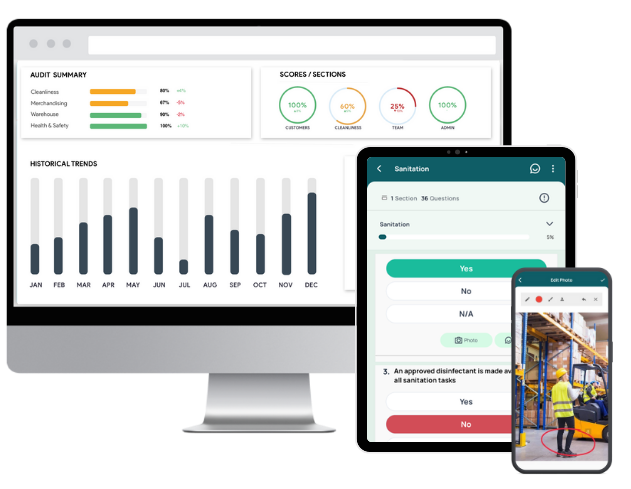
- GoAudits provides a simple, intuitive app to access health and safety audit checklists and complete workplace inspections and audits with ease, even without an internet connection. You can start with industry-standard templates or create your own checklists using a drag-and-drop interface.
- Capture and attach photos directly from the mobile app, annotate them, and provide clear visual evidence of issues. E-signatures, timestamps, and geolocation data enhance transparency and traceability across your inspections.
- EHS reports are instantly and automatically generated after each inspection or audit. These reports include all key data: scores, photos, comments, timestamps, user information, and assigned corrective actions.
- You can customize these EHS reports and share them with relevant stakeholders.
- Identify and assign corrective actions during the inspection. Each task includes priority, due date, and ownership details, ensuring full accountability.
- Track progress through a centralized dashboard. Filter tasks by due date, location, or status to ensure no action falls through the cracks.
- Gain real-time insights into your EHS performance. Analyze historical data, uncover trends, and pinpoint recurring issues. Assess overall audit outcomes or review performance by locations or departments.
- Set rules for approvals, task escalation, and report distribution. Spot delays early, coordinate across departments, and maintain full visibility.
How EHS Reporting Reduces Workplace Incidents
Here’s how EHS reporting contributes to a safer work environment:
- EHS reporting facilitates the prompt detection of potential hazards. By documenting near misses and unsafe conditions, you can identify risks before they result in incidents.
- When incidents occur, EHS reporting provides the data necessary for thorough root cause analysis. Understanding the underlying factors, whether they’re procedural flaws, equipment failures, or human errors, allows you to implement corrective actions that address the source of the problem, not just its symptoms.
- Aggregated EHS data reveals patterns and trends over time. By analyzing this information, you can pinpoint recurring issues or emerging risks, enabling you to allocate resources effectively and prioritize safety initiatives where they’re needed most.
- Regular reporting allows you to assess the effectiveness of existing safety protocols. If certain measures consistently fail to prevent incidents, it’s a clear indicator that revisions are necessary.
- Maintaining comprehensive EHS reports is essential for demonstrating compliance with health and safety regulations. Accurate reporting not only helps avoid legal penalties but also showcases your commitment to a safe workplace.
- Involving employees in EHS reporting fosters a culture of safety and accountability. When workers are encouraged to report hazards and near misses without fear of reprisal, they become active participants in the organization’s safety efforts.
- EHS reporting equips you with the insights needed to anticipate and mitigate risks before they escalate. By addressing potential issues early, you can prevent incidents, protect your workforce, and maintain uninterrupted operations.
What is EHS Incident Reporting Software
EHS incident reporting software is designed to help organizations efficiently capture, track, investigate, and report incidents related to environment, health, and safety (EHS) in the workplace. These incidents can include workplace injuries, illnesses, near misses, property damage, environmental spills, and more.
Key Features & Benefits of EHS Incident Reporting Software
Key features of EHS incident reporting software include:
Customizable Checklists for Safety Audits and Incident Reporting
Customizable checklists are essential for standardizing safety audits, EHS inspections, and incident reporting. These checklists can be tailored to specific organizational needs, ensuring comprehensive data collection. Features such as the ability to add photos, time stamps, and geolocation enhance the richness of the data captured.
Instant EHS Report Generation
Instant report generation allows for the immediate creation of detailed incident reports upon data entry. This feature is crucial for timely decision-making and compliance reporting. Instant report generation includes timeliness, compliance, and transparency.
Corrective and Preventive Actions (CAPA)
CAPA functionality helps organizations address non-conformances and prevent recurrence. By identifying root causes and implementing corrective and preventive measures, organizations can mitigate risks effectively. It ensures risk mitigation, continuous improvement, and accountability.
Workflow Automation
Workflow automation streamlines the incident management process by automating tasks such as approvals, notifications, and escalations. This reduces manual intervention, minimizes delays, and ensures consistent handling of incidents.
Data Analytics for Performance Analysis
Data analytics in EHS incident reporting software transforms raw incident data into actionable insights. By analyzing trends and identifying recurring issues, organizations can make informed decisions to enhance safety performance. It ensures proactive risk management, informed decision-making, and performance monitoring.
How to Choose the Right EHS Incident Reporting Software?
Here are some factors you should consider to choosing the right EHS incident reporting software:
- A good EHS incident reporting software should offer a balance between affordability and functionality. Compare pricing models, considering not only the initial cost but also the long-term value and any hidden fees for additional features or user licenses. Some software may offer scalable pricing based on the size of your organization, allowing you to start with a basic plan and upgrade as needed.
- Ensure the mobile app allows easy data entry, quick incident reporting, and seamless navigation. Offline functionality is essential, especially for remote or field workers who may not always have internet access, ensuring no incidents are missed.
- Choose a provider that offers comprehensive, reliable customer support, including training, troubleshooting, and consultation. Consider the availability of different support channels, such as live chat, phone support, and email.
- Look for customer reviews and testimonials from organizations similar to yours. Check various platforms for honest, unbiased opinions, and ask the vendor for case studies or references that demonstrate their software’s ease of use, reliability, and impact on safety management.
- Ensure the EHS incident reporting software complies with industry standards for data protection, such as encryption, secure access controls, and compliance with relevant regulations like GDPR or HIPAA. It helps prevent unauthorized access, data breaches, and compliance issues.
- Take advantage of free trials or personalized demos. They allow you to test the software’s features and usability firsthand. A demo or trial period will give you a clearer understanding of how the software integrates with your workflows and how well it meets your organization’s needs. Evaluate how quickly it can be set up and how intuitive it is to navigate.

